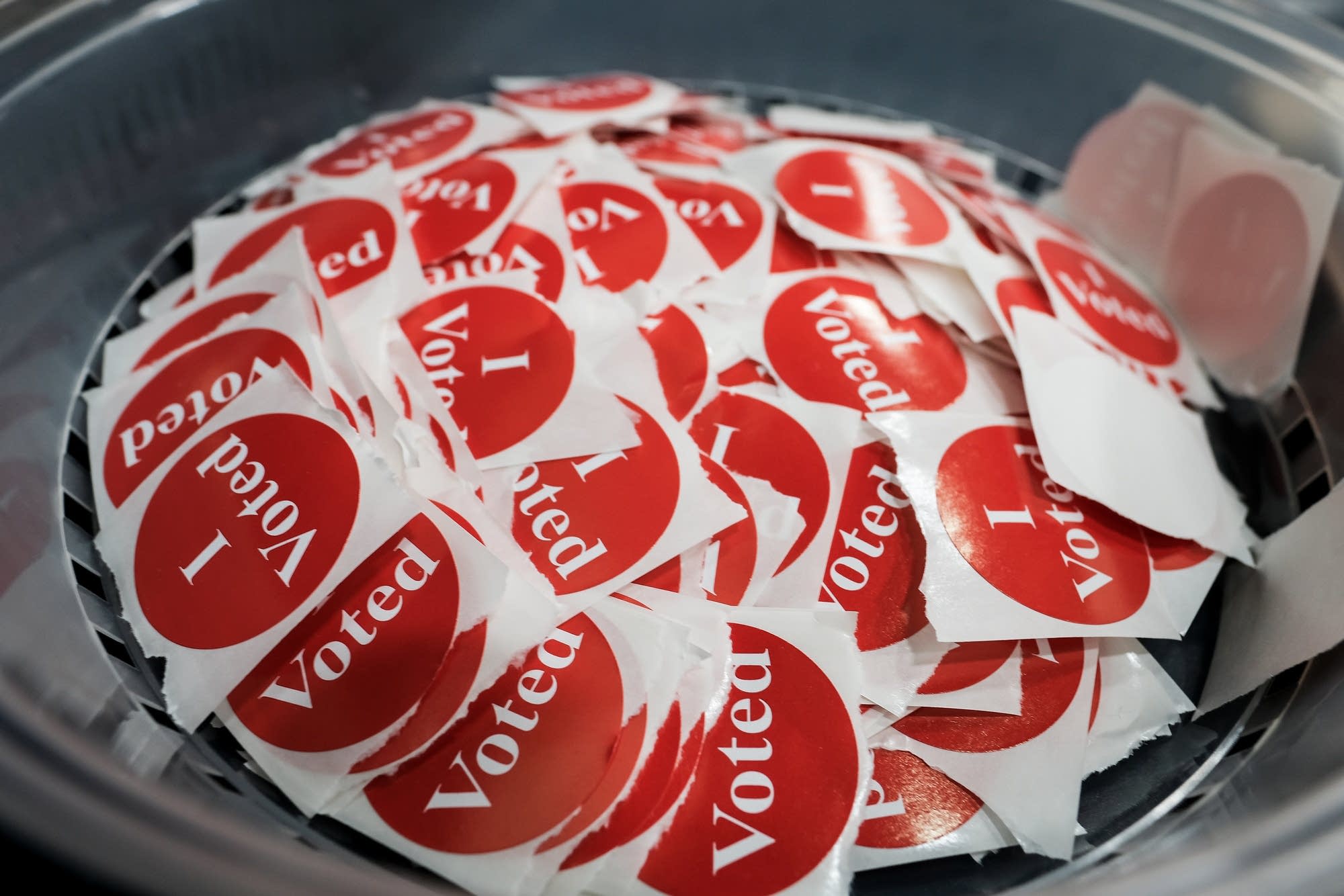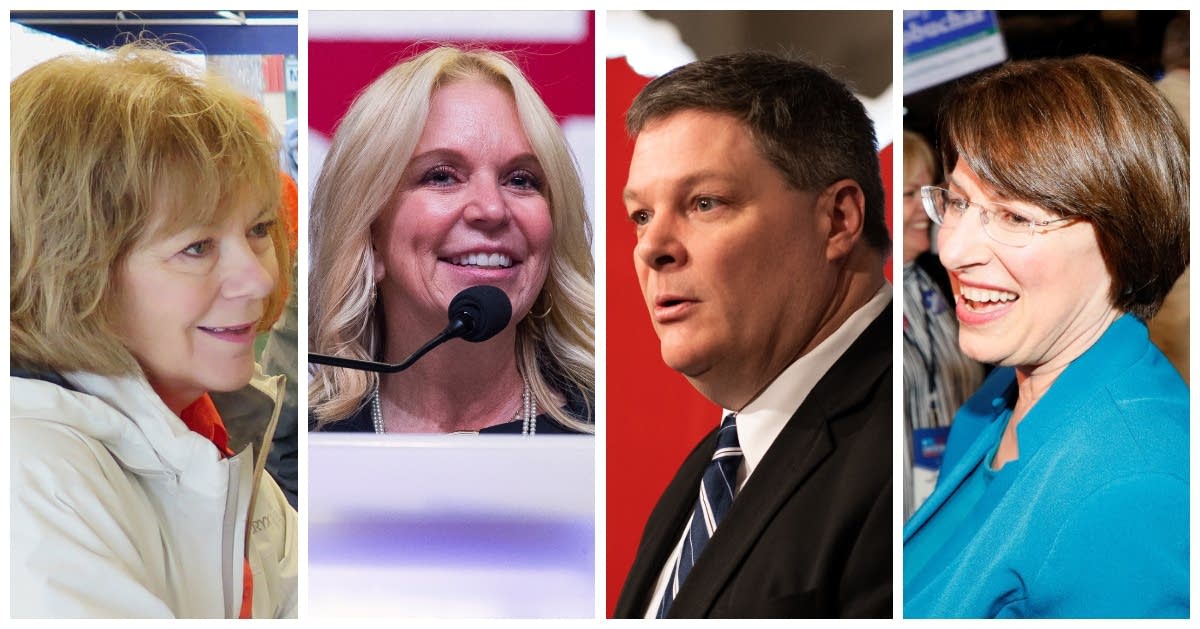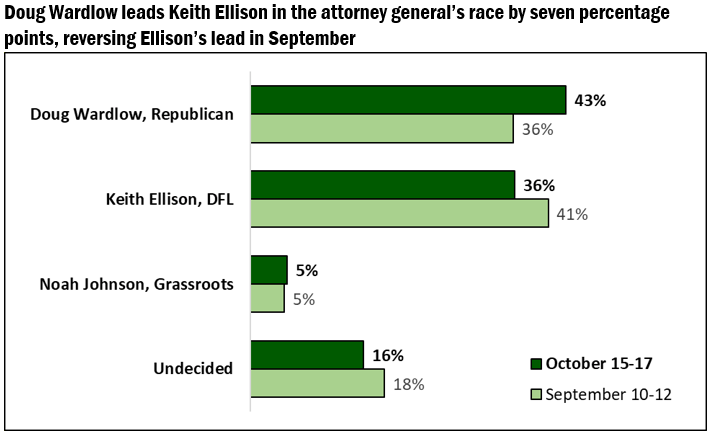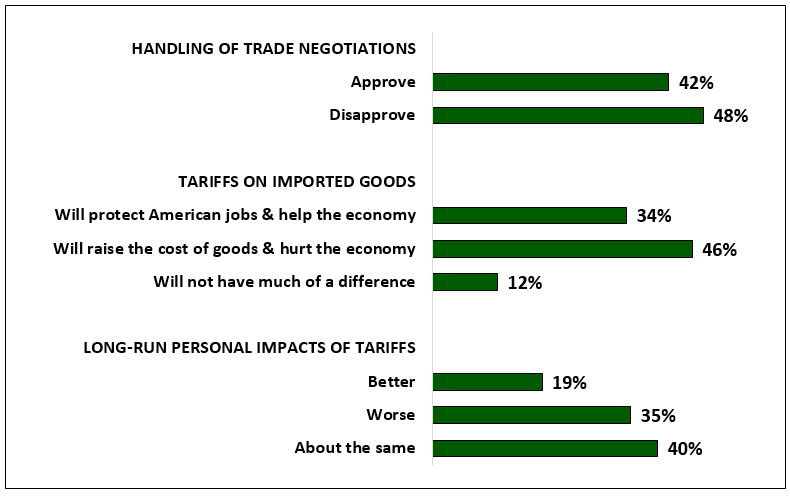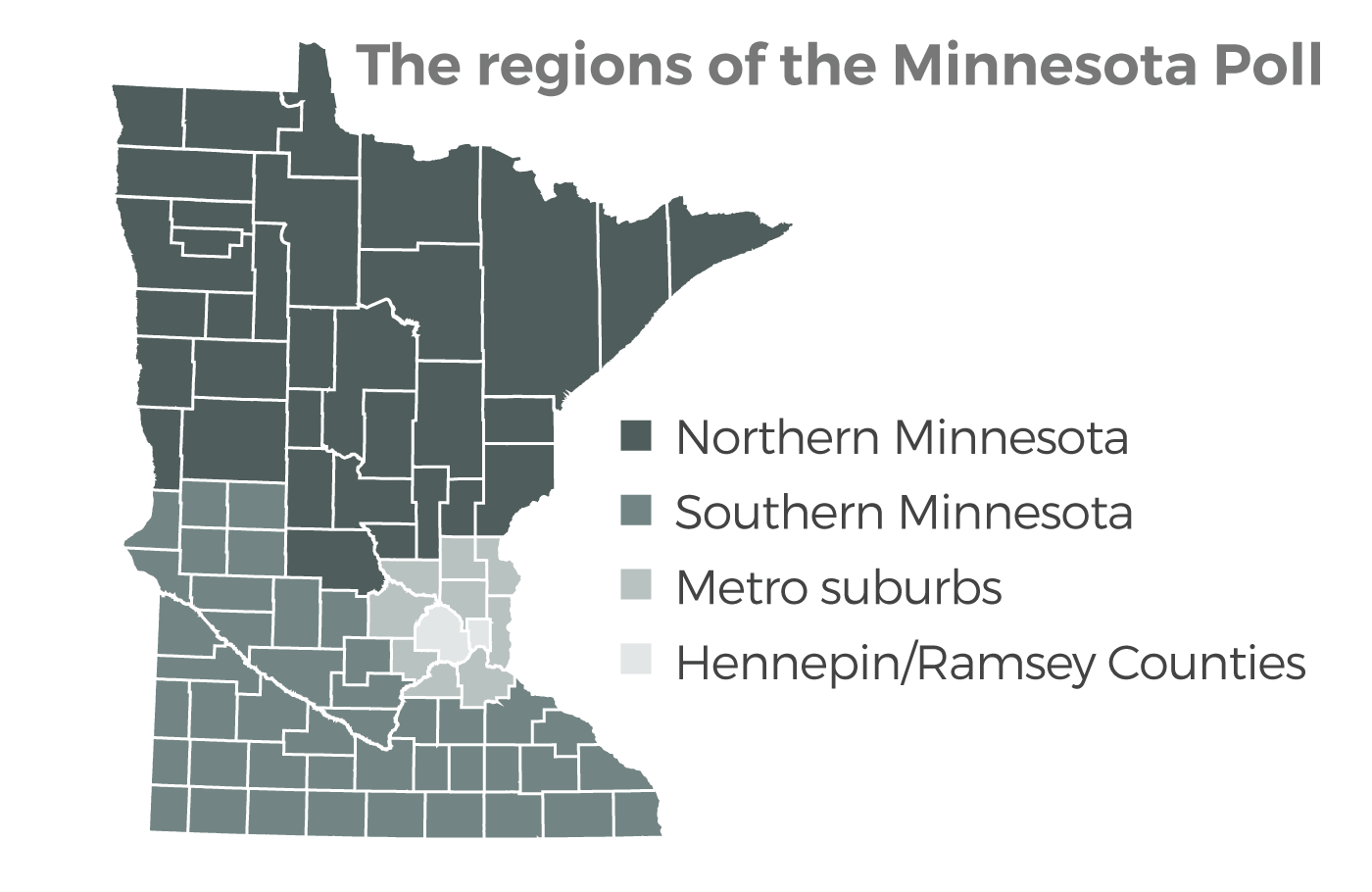Photo: Caroline Yang for MPR News.
by APM RESEARCH LAB | Oct. 31, 2018
The MPR News | Star Tribune Minnesota Poll interviewed 800 Minnesotans identified as likely voters, to understand their views on the race for governor and other offices, and on political issues in the news. The APM Research Lab provided consultation on the questionnaire and additional analysis of the results.
The latest Minnesota Poll was conducted October 15-17, 2018. It revealed Minnesotans’ opinions on the races for governor, Minnesota attorney general, and Minnesota’s U.S. Senate seats. The poll also asked about policy preferences about health care and raising the gas tax, agreement/disagreement with President Trumps’ policies on trade and immigration, the nomination of Brett Kavanaugh to the U.S. Supreme Court, and Governor Dayton’s favorability and approval after 8 years in office.For the previous Minnesota Poll, see the September 2018 results.
Jump to the poll results below.
The Governor’s Race: Tim Walz leads Jeff Johnson in the governor’s race by six points, but twelve percent of voters remain undecided
Question: “If the 2018 general election for Minnesota governor were held today, would you vote for…”
Source: MPR News | Star Tribune Minnesota Poll, October 15-17, 2018. N=800 registered Minnesota voters who are likely to vote in November; overall margin of error = +/-3.5 percentage points.
READ OUR BRIEF ON THE GOVERNOR’S RACE RESPONSES FROM THE MINNESOTA POLL
Democratic U.S. Representative Tim Walz currently leads Republican Hennepin County Commissioner Jeff Johnson in the race for the governor’s office by a six-percentage-point margin, but 12 percent of likely voters remain undecided.
Five percent of likely voters indicate that they prefer third party candidates, with three percent favoring Libertarian Josh Welter and two percent favoring Grassroots candidate Chris Wright.
Walz’s six percentage point lead is down slightly from his nine-point lead in last month’s Minnesota Poll.
Since September the proportion of likely voters who are undecided has decreased from 16 to 12 percent.
Similar to September, Walz has an advantage among women, younger voters, those living in Hennepin and Ramsey counties, and Democrats. He now also has a significant lead among those in households with annual incomes under $50,000.
Similar to September, Johnson has an advantage among older men and Republicans. Additionally, Johnson now has a significant lead among those living in the metro suburbs (nine counties surrounding Hennepin and Ramsey counties)
Support for Johnson also has grown among younger men and those living in Southern Minnesota—groups which were led by Walz in September and are now statistically tied.
Democratic candidate Tim Walz has somewhat higher favorability ratings than is the case for Republican candidate Jeff Johnson, although that gap has narrowed.
Similar to the September Minnesota Poll, Walz has maintained a higher percentage of favorable ratings than Johnson among women, young voters (age 18 to 34), and those with lower household incomes, those living in Hennepin and Ramsey counties, and Democrats
Walz’s overall favorable rating has barely moved since September, while the proportion indicating they have an unfavorable opinion of Walz grew from 13 percent to 23 percent.
In addition to Republicans, Johnson now has a significantly higher percentage of favorable ratings than Walz among those living in Northern Minnesota.
Overall, the portion indicating that they have a favorable opinion of Jeff Johnson increased from 26 percent in September to 32 percent in October.
RELATED COVERAGE:
WALZ LEADS, BUT MINNESOTA GOVERNOR’S RACE HAS TIGHTENED (MPR NEWS)
TIM WALZ HOLDS NARROW LEAD OVER JEFF JOHNSON FOR GOVERNOR (STAR TRIBUNE)
The U.S. Senate Races
Senate candidates (from left) Tina Smith, Karin Housley, Jim Newberger, and Amy Klobuchar.
Photo: MPR News.
Incumbent Democrat Amy Klobuchar leads Republican Jim Newberger by 23 percentage points (56% and 33%, respectively).
Two percent of likely voters indicate support for Green Party candidate Paula Overby, and another two percent support Dennis Schuller from Legal Marijuna NOW. Eight percent remain undecided.
Senator Klobuchar has near-universal name recognition among likely voters and 51 percent have a favorable opinion of her.
Without the context of the Senate race or his political party, three-fifths of likely voters do not recognize Doug Wardlow’s name.
Incumbent appointee, Democrat Tina Smith leads Republican Karin Housley by six percentage points (47% to 41%), but ten percent remain undecided.
One percent of likely voters support Sarah Wellington of Legal Marijuana NOW party and one percent support unaffiliated candidate Jerry Trooien.
Both Smith and Housley have increased their name awareness since the September Minnesota Poll: at that time one-quarter of likely voters failed to recognize Tina Smith’s name and nearly one-half failed to recognize Karin Housley’s name without the context of their Senate race or political party. In October those proportions decreased to 17 percent and 35 percent, respectively.
RELATED COVERAGE:
NEW POLL: KLOBUCHAR, SMITH LEAD IN MINNESOTA SENATE RACES (MPR NEWS)
SEN. AMY KLOBUCHAR OUT FROM OF STATE REP. JIM NEWBERGER; STATE SEN KARIN HOUSLEY
GAINS ON SEN. TINA SMITH (STAR TRIBUNE)
SENATOR AMY KLOBUCHAR IS MINNESOTA’S MOST BELOVED POLITICIAN (APM RESEARCH LAB)
Attorney General’s Race
Question: “If the 2018 general election for Minnesota attorney general were held today, would you vote for…”
Source: MPR News | Star Tribune Minnesota Poll, 2018. N=800 registered Minnesota voters who are likely to vote in November; overall margin of error = +/-3.5 percentage points.
READ OUR BRIEF ABOUT THE ATTORNEY GENERAL’S RACE
Republican former state Representative Doug Wardlow leads in his race with Democratic U.S. Representative Keith Ellison for the Minnesota’s Attorney General’s office by seven percentage points, but 16 percent of likely voters are undecided.
This result reverses the five-point lead held by Ellison in the September Minnesota Poll.
Wardlow leads among men, all age groups but the youngest (18-34), those with annual incomes of $50,000 or more, all regions of the state except Hennepin and Ramsey Counties, and Republicans as well as independents.
Ellison leads in Hennepin and Ramsey counties, as well as among Democrats, although one in five Democrats indicated they are not sure who they will vote for.
Five percent of likely voters indicate support for Noah Johnson, the Grassroots-Legalize Cannabis candidate for Minnesota attorney general.
Ellison leads Wardlow in favorable ratings, unfavorable ratings, and name recognition.
Without the context of a political race, or mention of party affiliation, 56 percent of likely voters do not recognize Doug Wardlow’s name. While this is down from 69 percent in September, 37 percent of Republican voters still do not recognize Wardlow’s name.
Besides Democrats, Ellison’s highest favorability ratings come from those living in Hennepin and Ramsey counties (31%). His unfavorable ratings are 40 percent or higher among men, those living in the suburbs, and independent voters.
The race for attorney general remains overshadowed by allegations of domestic abuse brought forward by Ellison’s former girlfriend.
The proportion of likely voters indicating that they believe the allegations has grown from 21 percent in September to 30 percent in the October Minnesota Poll.
Half of likely voters are not sure whether they believe the allegations.
Men, especially men age 50 or older, are more likely to believe the allegations than are women.
Thirteen percent of Democrats believe the allegations, as do 33 percent of independents and nearly half of Republicans.
RELATED COVERAGE:
WARDLOW MOVES AHEAD OF ELLISON IN MN ATTORNEY GENERAL RACE (MPR NEWS)
DOUG WARDLOW LEADS KEITH ELLISON IN ATTORNEY GENERAL’S RACE (STAR TRIBUNE)
Policy preferences: Health care and gas tax
Graphic: William Lager, MPR News.
READ OUR BRIEF ABOUT MINNESOTANS’ VIEWS AND PREFERENCES IN THE GOVERNOR’S RACE AND A PROPOSED GAS TAX
Fifty-two percent of the state’s likely voters think that it is the federal government’s responsibility to make sure all Americans have health care insurance; 40 percent think it is not the federal government’s responsibility, and eight percent are unsure.
Most Democrats (84%) think health care is the federal government’s responsibility, while most Republicans (70%) think it is not.
A strong majority of likely voters — 70 percent — support letting people buy in to public health insurance programs including Medicare and MinnesotaCare.
Support for this idea is widespread, including 82 percent among Democrats, 63 percent among Republicans, and another 63 percent among independents.
11 percent oppose the idea, and 19 percent are undecided.
A majority of likely voters indicated that they support raising the state tax on gasoline and other fuels by 10 cents per gallon to fund road and bridge construction and maintenance projects.
Overall, 56 percent of likely voters support an increase, and 36 percent are opposed. This split was similar among most groups represented in the survey: the majority of both men and women, younger and older Minnesotans, those from higher and lower income households, and those living in all four regions of the state indicated support for a gas tax increase.
Republicans and those planning to vote for Jeff Johnson are the only two groups where the majority is opposed to such a measure.
A strong majority of Democrats, independents, and those planning to vote for Tim Walz indicated support for increasing the gas tax.
Justice Brett Kavanaugh
Question: “Do you approve or disapprove of the confirmation of Brett Kavanaugh as a Supreme Court justice?”
Source: MPR News | Star Tribune Minnesota Poll, October 15-17, 2018. N=800 registered Minnesota voters who are likely to vote in November; overall margin of error = +/-3.5 percentage points.
READ OUR BRIEF ON VIEWS OF JUSTICE KAVANAUGH
Overall just under half of Minnesota voters approve of the confirmation of Brett Kavanaugh as a Supreme Court justice, while 43 percent disapprove, and eight percent are unsure.
There is a clear partisan split on this topic: 93 percent of Republicans approve of the confirmation of Brett Kavanaugh to the Supreme Court, while 84 percent of Democrats disapprove.
Independent voters are more divided amongst themselves, with a majority approving of the confirmation, while one-third disapproves.
Overall, 57 percent of men approve, and 36 percent disapprove, while the share of women who approve falls to 42 percent and grows for those who disapprove to 49 percent.
Kavanaugh’s confirmation to the Supreme Court also garnered approval by a majority of voters from the following groups: those who are at least 50 years of age, have an annual household income between above $50,000 and under $100,000, men at least 50 years of age, and residents of the metro suburbs, Northern, or Southern Minnesota.
The majority of likely voters disapprove of Kavanaugh’s confirmation among those who are age 18-34, have an annual household income of less than $25,000, are residents of Hennepin or Ramsey County, or are women age 18-49.
A majority of likely voters believe Kavanaugh will be an “independent and impartial” judge now that he has been confirmed.
There are strong partisan divides on this topic, with more than three-quarters of Democrats indicating they do not believe Kavanaugh will be independent and impartial, and 95 percent of Republicans saying he will be.
Mirroring their approval ratings of his confirmation, over half of independent voters believe Justice Kavanaugh will be independent and impartial, while one-third say he will not be.
Likely voters age 18-34 say the confirmation of Brett Kavanaugh to the Supreme Court makes them more likely to vote for Democrats, while 32 percent say Republicans. We see a similar pattern for women age 18-49 and residents of Hennepin and Ramsey Counties.
Men indicated they are more likely to vote Republican, while women indicated they are more likely to vote Democrat as a result of the confirmation of Brett Kavanaugh to the Supreme Court.
Likely voters with an annual household income of less than $50,000 said the confirmation of Kavanaugh makes them more likely to vote Democratic (45%) than Republican (30%).
Residents of the metro suburbs and Northern Minnesota are more likely to say the confirmation of Kavanaugh makes them more likely to vote Republican, whereas residents of Hennepin and Ramsey Counties are more likely to vote Democrat as a result of his confirmation.
Forty-one percent of likely voters do not believe the allegation of sexual assault against Kavanaugh, while 35 percent do believe it, and 24 percent are unsure.
Overall, there is no statistical difference between the share of men and women who believe the allegation (approximately one-third); however, considerably more men than women say they do not believe the allegation (48% and 35%, respectively).
Women voters age 18-49 are more likely to believe the allegations against Kavanaugh, with 4 in 10 saying this.
Men voters at least 50 years of age are almost twice as likely to say they do not believe the allegations against Kavanaugh (52%) compared to those who do believe (27%) or unsure if they believe the allegation (21%).
At least 45 percent of voters who are at least 50 years of age, have an annual household income over $50,0000, or live in the metro suburbs, Southern, or Northern Minnesota do not believe the allegations.
In Hennepin and Ramsey Counties, a plurality of likely voters believes the allegation (48%), while approximately one-quarter do not believe the allegations or are unsure.
Allegations against Justice Kavanaugh are different in nature than are the allegations against Representative Keith Ellison, and so are the responses of likely voters to those allegations, as noted in a special section concluding the body of the brief.
RELATED COVERAGE:
POLL: KAVANAUGH, #METOO LOOM LARGE IN 2018 MINNESOTA RACES (MPR NEWS)
IN MINNESOTA POLL, DIVISIONS LINGER OVER SUPREME COURT JUSTICE BRETT KAVANAUGH (STAR TRIBUNE)
President Trump’s Trade Policy: Minnesota voters have mixed views on President Trump’s trade policy
Question: See Appendix 3 of brief.
Source: MPR News | Star Tribune Minnesota Poll, October 15-17, 2018. N=800 registered Minnesota voters who are likely to vote in November; overall margin of error = +/-3.5 percentage points.
READ OUR BRIEF ON VIEWS OF PRESIDENT TRUMP’S TRADE POLICY
Somewhat more Minnesota voters disapprove (48%) than approve (42%) of President Trump’s handling of trade negotiations.
A majority of women voters, and those under age 50 disapprove of President Trump’s trade negotiations. A majority of male voters age 50 or older approve of the President’s approach to trade.
A majority of voters living in Hennepin and Ramsey counties disapprove of President Trump’s trade negotiations, while a majority of those living in Northern Minnesota approve of the President’s approach. Those living in the metro suburbs and Southern Minnesota are evenly split.
Views on President Trump’s handling of trade negotiations split along party lines as would be expected, with strong majorities of Republicans and those favoring Republican candidates approving, and strong majorities of Democrats and those favoring DFL candidates disapproving.
Independent voters, who make up 29 percent of likely voters in Minnesota according to this poll, are evenly split on approving and disapproving of the President’s approach to trade negotiations.
When asked which statement regarding the tariffs President Trump has imposed on imported goods most closely resembles their own view, nearly half of Minnesota voters chose “they will raise the cost of consumer goods and hurt the U.S. economy.”
One-third indicate “they will protect American jobs and help the U.S. economy,” and one-in-five either indicate that “they will not have much of a difference” or are unsure what the impacts of tariffs will be on the economy.
Over half of women voters, voters under age 50, and nearly half of voters with annual incomes under $50,000 believe that tariffs will raise costs and hurt the economy.
A majority of voters living in Hennepin and Ramsey counties believe that the President’s tariffs will have a harmful impact on the economy, while voters in suburban and greater Minnesota are evenly split on how tariffs will impact the economy.
Views on the broad economic impacts of the tariffs imposed “by President Trump” split along party lines as would be expected, with strong majorities of Republicans and those favoring Republican candidates indicating the tariffs with help, and strong majorities of Democrats and those favoring DFL candidates indicating tariffs will hurt the U.S. economy.
Nearly half of Independent voters think that the tariffs will harm the U.S. economy, and only a quarter think they will help. One in five Independents say that they do not think the tariffs will have much of a difference.
When asked “In the long run, do you think the tariffs imposed by President Trump will leave you personally better off financially, worse off or about the same?” the largest proportion of Minnesota voters, 40 percent, indicate “about the same.”
Only one-in-five think the tariffs will make them better off, while one-third think the tariffs will harm their personal finances.
About as many men think the tariffs will make their personal finances better as think the tariffs will make their finances worse. Women are much more likely to think that the tariffs will be harmful to their own personal finances.
In no region of the state do more voters think the tariffs will leave them better off than worse off. Those living in both Hennepin and Ramsey counties, as well as Southern Minnesota are significantly more likely to say that the tariffs will make them worse off.
A majority of Democrats and those favoring DFL candidates indicate that the tariffs imposed by President Trump will personally make them worse off.
Forty-five percent of Independents indicated that the tariffs will leave them “about the same” financially, and only 17 percent indicate that they think the tariffs will improve their finances.
While 40 percent of Republicans think that the tariffs imposed by President Trump will make them better off in the long run, even more (51%) indicate that the tariffs will have little impact on their personal finances.
RELATED COVERAGE:
MINNESOTA POLL SHOWS SPLIT ON TRADE POLICY, TARIFFS (STAR TRIBUNE)
POLL: TRUMP TRADE POLICY DIVIDES MINNESOTA VOTERS (MPR NEWS)
Immigration policy
Photo: Hannah Kangas | MPR News.
Just over half of likely voters in Minnesota disapprove of President Trump’s handling of U.S. immigration policy; 42 percent approve.
Two-thirds of those living in Hennepin and Ramsey counties – home to over half of the state’s immigrant population – disapprove. A majority of those living in Northern Minnesota – which is home to fewer immigrants than any of the other 3 regions included in the poll – approve of the President’s immigration policy.
Over half of all women voters, voters under age 50, and those with annual incomes below $50,000 disapprove of the President’s immigration policy.
President Trump’s immigration policy is highly partisan: 85 percent of Republican voters approve, while 96 percent of Democrats disapprove. Independent voters are evenly split.
Nearly 60 percent of Minnesota voters oppose building a wall along the Mexican border if the U.S. has to pay for it.
Opposition to the border wall is nearly unanimous among Democrats, but it is also opposed by a quarter of Republicans, and over half of independents.
When presented with three potential options for dealing with undocumented immigrants, half of Minnesota’s likely voters favored allowing them to “stay and become U.S. citizens if they meet certain requirements over time.”
This was the most favored option in all regions of the state, among all age groups and both men and women voters.
There is little consensus among the state’s Republicans: 20 percent say undocumented immigrants should be deported, 40 percent say they should be allowed to stay to work without becoming citizens, and 34 percent agree there should be a path to citizenship.
When asked to choose between 4 potential courses of action regarding refugee resettlement in the state, Minnesota voters were split:
One-quarter favor “temporarily stop accepting refugees”
One-quarter favor “maintain the current average of 1,000 new refugees per year”
One-quarter favor “return to the average of 2,000 per year that was normal prior to 2016”
12 percent favor “increase the average to about 3,000 per year”
The only group that departs in a substantial way from that pattern is the state’s Republican voters, among whom nearly half favor a temporary stop, with most of the rest (38%) favoring accepting 1,000 refugees per year.
RELATED COVERAGE:
MINNESOTANS IN POLL OBJECT TO TRUMP IMMIGRATION POLICIES, SPLIT OVER REFUGEE RESETTLEMENT (STAR TRIBUNE)
MOST MINNESOTA VOTERS DISAGREE WITH TRUMP ON IMMIGRATION (MPR NEWS)
Governor Dayton’s favorability, approval after 8 years in office
Minnesota Governor Mark Dayton speaks to a large crowd during Minnesota Supreme Court justice Paul Thissen's swearing in ceremony at the Landmark Center in St. Paul on July 24, 2018. Dayton is currently serving in his last term as Minnesota's governor.
Photo: Lacey Young | MPR News.
READ OUR BRIEF ON FAVORABILITY AND JOB APPROVAL OF GOVERNOR DAYTON
Overall, 4 in 10 Minnesota voters have a favorable opinion of Governor Mark Dayton, while approximately 3 in 10 have an unfavorable or neutral opinion of him.
The share of women voters’ who hold favorable, unfavorable, and neutral opinions of the outgoing governor mirror those of the Minnesota voters overall.
While in September a significantly higher number of men voters viewed Dayton unfavorably (43%) than favorably (32%), this latest poll shows men voters are split on how they feel.
Minnesota voters with an annual household income of less than $50,000 are more likely to have a favorable opinion of Governor Dayton than those making at least $50,000.
Regionally, voters in the Northern region, Southern region, and metro suburbs are almost split equally in how they feel about the governor, with around one-third in each of the favorability categories. However, nearly half of voters in Ramsey and Hennepin Counties view Governor Dayton favorably.
Unsurprisingly, there is a big partisan divide on DFL Governor Dayton’s favorability, with three-quarters of Democrats finding Dayton favorable and 61 percent of Republicans finding him unfavorable.
When it comes to the upcoming gubernatorial race, approximately 7 in 10 voters who support DFL candidate Tim Walz view Dayton favorably, while a similar share of voters who back Republican candidate Jeff Johnson hold and unfavorable opinion of the outgoing governor.
When asked if they approve of Governor Dayton’s job performance during his two terms in office, a majority of voters indicated that they approve.
Among the 57 percent who approve of Governor Dayton’s job performance, over half indicate that they “strongly approve.”
Among the 41 percent who disapprove, 63 percent indicate that they “strongly disapprove.”
While men are split relatively evenly in approving and disapproving, 6 in 10 women voters approve of Governor Dayton’s job performance.
In Hennepin and Ramsey counties, 7 in 10 voters approve of Dayton’s tenure as governor, while that number drops to around half for voters in the rest of the state.
Ninety-two percent of Democrat voters approve of the outgoing governor, as do one in five Republicans. However, the majority of Republicans — 77 percent — disapprove.
Of those who would vote for Walz, 94 percent approve of Dayton’s job performance, while that number falls to 14 percent among Johnson supporters.
SURVEY BACKGROUND AND METHODS
This survey is the result of a collaboration between Minnesota Public Radio News and the Star Tribune. It is a continuation of the Star Tribune’s periodic Minnesota Poll feature.
Regions surveyed for MPR News | Star Tribune Minnesota Poll
Graphic: William Lager | MPR News.
Mason-Dixon Polling & Strategy, Inc. of Jacksonville, Florida, designed and executed the survey, including sample construction and screening procedures, data collection, and analysis. The poll was conducted from October 15 through October 17, 2018. A total of 800 registered Minnesota voters were interviewed statewide by telephone. All indicated they were likely to vote in the November general election. See summary findings compiled by Mason-Dixon .
Those interviewed were randomly selected from a phone-matched Minnesota voter registration list that included both land-line and cell phone numbers. Quotas were assigned to reflect voter turnout by county. The data were not weighted.
The overall margin for error is no more than ± 3.5 percentage points. This means that there is a 95 percent probability that the "true" figure would fall within that range if all likely voters were surveyed. The margin for error is higher for any subgroup, such as sex or age grouping.

